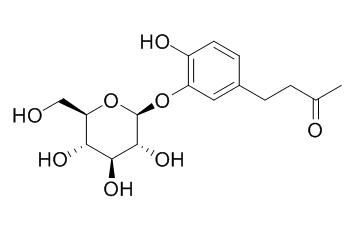Myzodendrone
Myzodendrone is a highly effective as free radical scavenger.
Inquire / Order:
manager@chemfaces.com
Technical Inquiries:
service@chemfaces.com
Tel:
+86-27-84237783
Fax:
+86-27-84254680
Address:
1 Building, No. 83, CheCheng Rd., Wuhan Economic and Technological Development Zone, Wuhan, Hubei 430056, PRC
Providing storage is as stated on the product vial and the vial is kept tightly sealed, the product can be stored for up to
24 months(2-8C).
Wherever possible, you should prepare and use solutions on the same day. However, if you need to make up stock solutions in advance, we recommend that you store the solution as aliquots in tightly sealed vials at -20C. Generally, these will be useable for up to two weeks. Before use, and prior to opening the vial we recommend that you allow your product to equilibrate to room temperature for at least 1 hour.
Need more advice on solubility, usage and handling? Please email to: service@chemfaces.com
The packaging of the product may have turned upside down during transportation, resulting in the natural compounds adhering to the neck or cap of the vial. take the vial out of its packaging and gently shake to let the compounds fall to the bottom of the vial. for liquid products, centrifuge at 200-500 RPM to gather the liquid at the bottom of the vial. try to avoid loss or contamination during handling.
Heliyon.2024, 10(7):e28364.
Pharmaceutics.2022, 14(5):945.
Processes2021, 9(1), 153;
Mol Cancer Ther.2024, 1535-7163.
J Biochem Mol Toxicol.2025, 39(8):e70416.
Oncotarget.2016, 8(51):88386-88400
J Agric Food Chem.2021, 69(14):4210-4222.
Biochem Biophys Res Commun.2020, 522(4):1052-1058
J. Soc. Cosmet. Sci. Korea2021, 47(1):57-63
Molecules.2019, 24(19):E3417
Related and Featured Products
Phytother Res. 2005 Dec;19(12):1043-7.
Antioxidant and free radical scavenging activities of Misodendrum punctulatum, myzodendrone and structurally related phenols.[Pubmed:
16372370 ]
METHODS AND RESULTS:
The peroxyl radical scavenging activity of a dry methanol extract of Misodendrum punctulatum was determined by means of luminol-enhanced chemiluminescence assay, allowing to calculate the total reactive antioxidant potential (TRAP) index equal to 239 +/- 26 microm, expressed in Trolox equivalents. The flavan-3-ol catechin (1) and the phenylbutanone derivative Myzodendrone (2) were identified through assay-guided fractionation as active metabolites present in the extract, and their structures were elucidated by chemical and spectroscopic analysis. Three other structurally related synthetic phenols, dehydrozingerone (3), zingerone (4) and Myzodendrone aglycone (5), were also analysed using this method.
CONCLUSIONS:
Compounds 1 and 2 were highly effective as free radical scavengers (TRAP = 1257 microm and 1018 microm, respectively) when compared with Trolox (TRAP = 144 microm), used as a standard. Compounds 3 and 5 were also active showing TRAP values of 229 microm and 219 microm, respectively, similarly to that observed for the dry extract. On the other hand, 4 was inactive.
Catechin (1) also reduced the production of thiobarbituric acid reactive substances (TBARS) in rat liver homogenates, with IC50 = 26 microg/mL, superior to that obtained for Trolox, IC50 = 73 microg/mL. Compounds 2 and 5 showed IC50 values > 1000 microg/mL, while no activity could be observed for 3, 4, or the extract.
Phytochemistry. 2003 Aug;63(8):959-64.
Glucosides from Vitex agnus-castus.[Pubmed:
12895546]
METHODS AND RESULTS:
The methanolic extract of the flowering stems of Vitex agnus-castus yielded three new iridoids: 6'-O-foliamenthoylmussaenosidic acid (agnucastoside A), 6'-O-(6,7-dihydrofoliamenthoyl)mussaenosidic acid (agnucastoside B) and 7-O-trans-p-coumaroyl-6'-O-trans-caffeoyl-8-epiloganic acid (agnucastoside C) in addition to four known iridoids (aucubin, agnuside, mussaenosidic acid and 6'-O-p-hydroxybenzoylmussaenosidic acid) and one known phenylbutanone glucoside (Myzodendrone).
CONCLUSIONS:
The structure elucidations were mainly done by spectroscopic methods (1D and 2D NMR spectra) and MS data interpretation. The purified compounds were tested for biological activities against various microorganisms and cancer cell lines.



